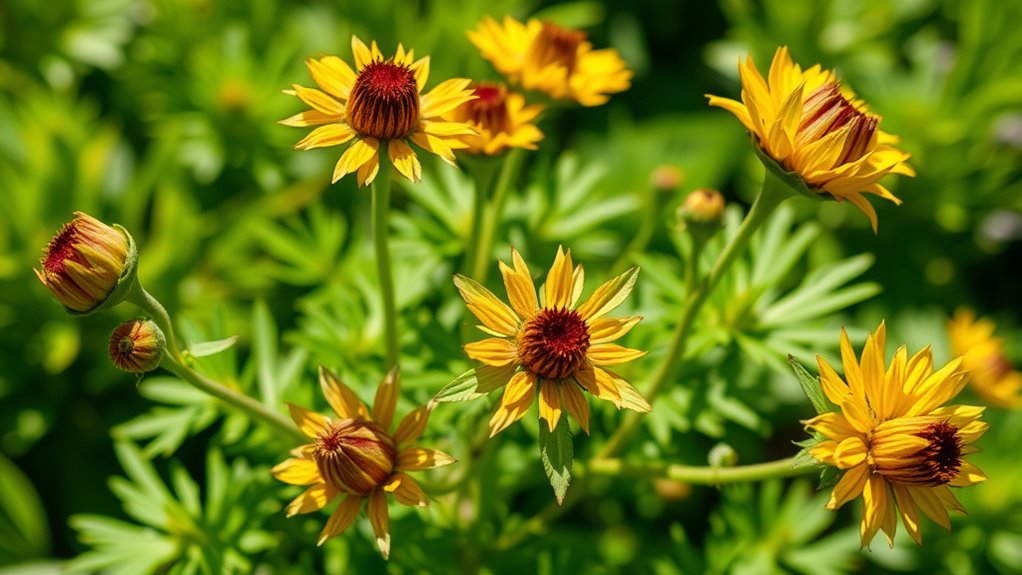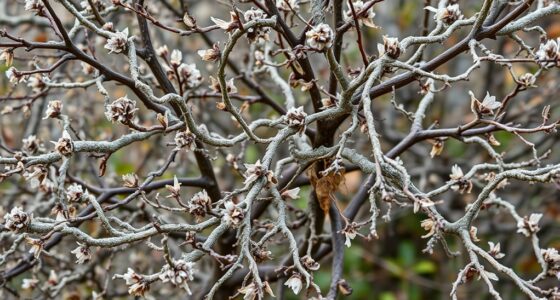To get your coreopsis to bloom again, start deadheading faded flowers regularly to encourage new blooms. Make sure it gets at least six hours of direct sunlight daily, as insufficient light can curb flowering. Check for nutrient deficiencies; a balanced fertilizer high in phosphorus helps promote flowers. Keep the soil moist but well-drained, incorporating organic matter when needed. For more tips on reviving your coreopsis’s brightness, continue exploring the key strategies that boost its health and blooms.
Key Takeaways
- Regularly deadhead spent blooms to promote continuous flowering and prevent seed formation.
- Ensure your coreopsis receives at least six hours of direct sunlight daily for optimal blooming.
- Check for nutrient deficiencies; use a phosphorus-rich fertilizer to encourage vibrant flowers.
- Maintain even soil moisture and good drainage to support healthy root growth and flowering.
- Inspect for pests or diseases that may weaken the plant and reduce bloom production.
Understanding the Importance of Deadheading for Coreopsis

Have you ever wondered why your coreopsis plants stop blooming prematurely? Proper pruning techniques are vital to keeping your plants vibrant. Deadheading, or removing spent flowers, encourages new blooms and prevents your plant from going to seed too early. This simple step not only boosts flowering but also minimizes the risk of pests that target old, decaying plant material. Pest prevention is essential, as pests often hide in dead or dying blooms, weakening the plant over time. Regular deadheading helps maintain plant health by reducing pest habitats and promoting vigorous growth. Additionally, choosing appropriate wicking materials for self-watering planters can support healthy root systems, ensuring your coreopsis receives consistent moisture. Incorporating effective light conditions can further enhance flowering and overall plant vigor. Practicing space optimization in your garden can improve airflow and reduce disease susceptibility, further promoting healthy growth. By staying consistent with pruning techniques and monitoring for pests, you’ll guarantee your coreopsis stays healthy and blooms abundantly throughout the season.
How to Properly Deadhead Your Coreopsis Plants

To keep your coreopsis blooming profusely, it’s vital to deadhead the flowers correctly. Use sharp pruning techniques to remove faded blooms just above the next set of healthy leaves. This encourages new flowering and prevents seed formation, which can slow down blooming. Make sure you deadhead regularly during the growing season to maintain continuous color. Additionally, adjust your watering schedule to keep the soil consistently moist but not waterlogged, as overwatering can weaken the plant and reduce blooms. Proper pruning techniques combined with attentive watering will promote healthier growth and more abundant flowering from your coreopsis. Incorporating watering pots with self-watering features can help maintain optimal moisture levels, ensuring your coreopsis thrives and blooms beautifully. Regularly inspecting your plant for signs of soil moisture imbalance can further help you adjust watering practices effectively. Paying attention to soil health and providing necessary nutrients will also support vibrant blooms.
Ensuring Adequate Sunlight for Optimal Blooming

Proper sunlight exposure is key to maximizing your coreopsis’s blooming potential. Make sure your plant receives at least six hours of direct sunlight daily, which encourages healthy growth and vibrant flowers. Adjust your watering schedule so the soil stays moist but not waterlogged, as overly wet soil can weaken your plant and reduce blooms. When managing pests, check regularly for insects that can damage leaves and stems, hindering sunlight absorption. Healthy, pest-free foliage allows more light to reach the plant, boosting flowering. If your coreopsis isn’t getting enough sun, consider relocating it to a sunnier spot. Light requirements are essential for optimal flowering, and consistent sunlight, proper watering, and vigilant pest management work together to promote abundant blooms and a thriving coreopsis.
Recognizing and Correcting Nutrient Deficiencies

Nutrient deficiencies can quietly hinder your coreopsis’s ability to produce vibrant blooms, so it’s essential to recognize the signs early. Look for pale, yellowing leaves or stunted growth, which often indicate nutrient shortages. To identify specific deficiencies, perform soil testing; this helps determine which nutrients are lacking. Once you know what’s missing, choose the right fertilizer to correct the imbalance. For example, a fertilizer high in phosphorus encourages blooming, while nitrogen promotes healthy foliage. Be sure to follow the recommended application rates to avoid over-fertilizing, which can cause other problems. Regular soil testing and proper fertilizer selection help ensure your coreopsis has the nutrients it needs to bloom abundantly and stay healthy throughout the season. Additionally, understanding plant nutrition can improve your overall gardening success, especially when considering how nutrient deficiencies impact flowering. Recognizing soil health is also crucial, as healthy soil supports optimal nutrient availability and plant growth.
Tips for Maintaining Healthy Soil Conditions

Maintaining healthy soil conditions is essential for encouraging coreopsis to produce vibrant blooms. Start by establishing a consistent watering schedule that keeps the soil evenly moist but not waterlogged. Overwatering can lead to root rot, while underwatering stresses the plant, reducing flowering. Additionally, healthy soil promotes strong root development and nutrient uptake. Regular pest control is also vital; pests like aphids and snails can damage roots or leaves, hindering growth. Use organic methods whenever possible to keep pests in check without harming beneficial soil organisms. Incorporate compost or organic matter into the soil to improve drainage and nutrient content. Ensuring proper soil health supports healthy growth and flowering. Proper nutrient levels in the soil are crucial for the plant’s development and blooming cycle. By balancing watering and pest management, you create an ideal environment for your coreopsis to thrive and bloom abundantly. Maintaining soil fertility also helps sustain consistent flowering throughout the growing season.
Additional Care Practices to Encourage Abundant Flowers

To encourage your coreopsis to produce abundant flowers, consider regular deadheading spent blooms. Removing faded flowers signals the plant to focus energy on new growth and flowering. Additionally, practicing thoughtful companion planting can help by pairing coreopsis with plants that attract pollinators or deter pests, boosting overall health and flowering. Maintaining a consistent watering schedule ensures the soil stays evenly moist but not waterlogged, preventing stress that can hinder bloom production. Mulching around the base of your plants can help retain moisture and regulate soil temperature. Avoid overwatering, which can lead to root rot, and ensure good air circulation around your plants to reduce disease risk. These practices create an ideal environment, encouraging your coreopsis to flourish with vibrant, plentiful blooms. Proper care practices are essential for long-term plant health and optimal flowering performance.
Frequently Asked Questions
How Often Should I Water My Coreopsis During the Blooming Season?
During the blooming season, you should water your coreopsis regularly, about once a week, ensuring the soil stays evenly moist but not soggy. Adjust your watering schedule if there’s heavy rain or drought conditions, as coreopsis has good drought tolerance once established. Keep an eye on the soil moisture to prevent overwatering, which can lead to root rot, and provide consistent moisture for vibrant, continuous blooms.
Are There Specific Pests That Target Coreopsis and Hinder Blooming?
You should be aware that certain pests, like aphids and spider mites, can target your coreopsis and hinder blooming. To prevent these issues, practice pest prevention by regularly inspecting your plants and removing affected foliage. Encouraging beneficial insects, such as ladybugs and lacewings, helps naturally control pests. Keeping plants healthy through proper watering and fertilizing also makes them more resistant, ensuring vibrant blooms and a thriving garden.
Can Over-Fertilizing Cause Coreopsis to Stop Blooming?
Yes, over-fertilizing your coreopsis can lead to bloom suppression. Excessive fertilizer overuse encourages lush foliage growth at the expense of flowers, making your plants focus on leafy development rather than blooming. To prevent this, use a balanced, slow-release fertilizer sparingly and follow recommended application rates. Proper feeding guarantees your coreopsis stays healthy and blooms profusely, avoiding the negative effects of fertilizer overuse.
What Temperature Ranges Are Ideal for Coreopsis Flowering?
Imagine you’re in a daisy chain of perfect conditions! For your coreopsis, ideal temperatures range between 70-85°F during the day and 55-60°F at night. It thrives in well-drained soil with a slightly acidic to neutral pH. Keep frost tolerance in mind—plants can handle light frosts but prefer warmth for abundant blooms. Maintaining these temperatures supports healthy flowering and vibrant blooms.
How Can I Propagate My Coreopsis Plants Effectively?
To propagate your coreopsis effectively, start with healthy parent plants. Use propagation techniques like division or cuttings in early spring or late summer. Prepare well-draining soil by loosening it and mixing in compost. For cuttings, dip the stems in rooting hormone, then plant them in moist soil. Keep the soil consistently damp and place the new plants in a sunny spot to encourage roots and healthy growth.
Conclusion
When you deadhead and provide your coreopsis with enough sunlight and nutrients, it’s like guiding a garden to bloom its best. Think of your plants as performers on a stage—removing faded blooms and fueling them with the right conditions keeps their energy focused on producing vibrant flowers. With consistent care, you’ll see your coreopsis dance with color, transforming your garden into a lively, cheerful masterpiece that feels almost magical.









